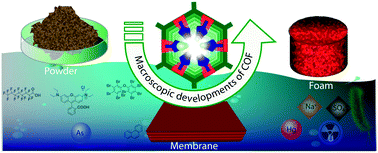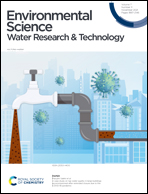Macroscopic covalent organic framework architectures for water remediation
Abstract
Covalent organic frameworks (COFs) are two- (2D) or three-dimensional (3D) crystalline and porous polymers constructed from organic molecules with various symmetries. The reticular synthetic strategy and the dynamic covalent chemistry of COFs allow the construction of regular intrinsic pores with stable functional covalent pore walls. The unique chemical structural features of COFs promote excellent molecular adsorption from various environments, especially from water. In this regard, COFs have been explored for their water remediation ability to a wide range of pollutants including persistent organic pollutants, toxic metals, radio-active wastes, etc. Notably, the development of COFs into various macrophysical forms such as foams and thick and thin-film membranes led to a new direction of advanced level water treatment. In this review, we have discussed the progress of the macroscopic architecture of COFs for water purification research. The notable shift from the granular adsorption of molecular pollutants to rapid and efficient foam-based adsorption and size and chemo-selective membrane-based separation is highlighted in this review. Finally, we have discussed our perspective on the future of this area of research for the next level of remediation technology of polluted water.

- This article is part of the themed collections: Environmental Science: Water Research & Technology Recent Review Articles, Recent Open Access Articles and Best Papers 2021 - Environmental Science: Water Research & Technology


 Please wait while we load your content...
Please wait while we load your content...